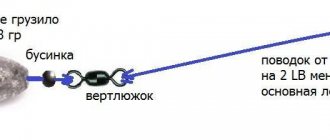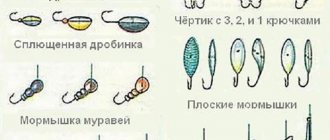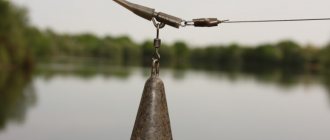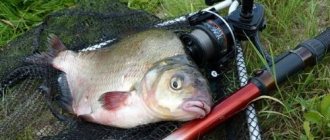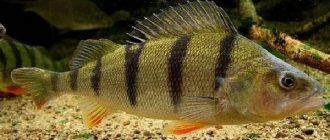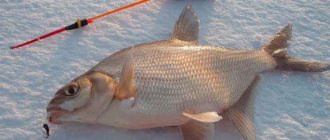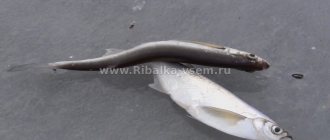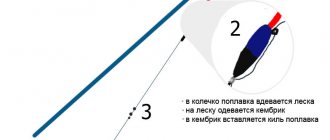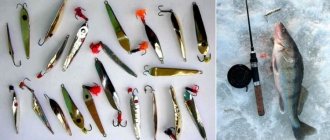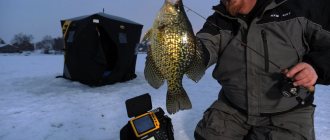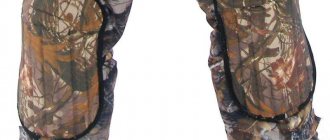Winter fishing, unlike summer fishing, requires much more gear, tools and equipment. Preparation for it begins in advance, taking into account the type of fish that will be hunted.
Along with the selection of warm clothes, an ice auger, a box, a hook, a tent and other basic accessories, special attention is paid to the preparation of gear. Numerous details must be taken into account, which ultimately can have a serious impact on the success of the venture. In the current material we will figure out what you need for winter fishing.
Fishing rod
Of course, the main tool of any fisherman is a fishing rod. Its winter version has a small size and design features, which will be discussed below. They often purchase several fishing rods at once and equip them differently. This tool should have optimal weight and a comfortable handle that can be easily held with or without gloved hands.
|
If you don’t want to go into details, then you should buy a balalaika. This is the most versatile fishing rod in which the reel also acts as a handle. For a more detailed look, let’s look at the three main types of this tool.
Float rod
It is the most popular among fishermen because it is suitable for catching many types of fish. Live bait or its imitation is used as bait.
The design of such a fishing rod consists of the following elements:
- a fishing rod (frame) equipped with a reel or reel (manual principle of winding line);
- fishing line or braided thread;
- float;
- a weight equipped with a hook or various types of jigs.
Such fishing gear for winter fishing does not require active action. All you have to do is feed the hole, throw in the bait and wait for a bite.
Fishing rod with a nod
This type of fishing rod differs from the previous one in that the float is replaced by a nod. With the help of such a device, the same types of fish are caught. The difference lies in the actions of the fisherman himself. A person must constantly move and play with the bait. Occasionally, live bait clings to the jig, but mostly baitless options are used.
The key to success in this case will be the correct selection of jig weight, which is based on the current at the fishing site and the current depth. It is also important to choose a nod that is appropriate in terms of rigidity - this will allow you to easily notice a bite without spoiling the game of the bait.
Fishing rod
Predators are caught using vertical trolling gear, which consists of the following elements:
- the rod is no longer than a meter;
- inertia type coil;
- fishing line;
- spoon or balancer for winter fishing.
It is important that the tackle has a safety margin. When fishing for a strong predator, it would be unforgivable to miss the prey at the last stage of fishing. The reliability of the gear is determined not only by the quality of the materials, but also by the preparation of the fisherman:
- It is necessary to place guide rings (3-4 pieces) of large diameter on the rod.
- A lubricant is applied to the moving parts of the reel so that it does not freeze in severe frost.
- During the fishing process, you should periodically clear the line of ice crust, which will constantly freeze. If this is not done, the thread will lose strength and may break with less force than expected.
- The hook located on the spoon must be well sharpened and able to withstand the weight of the prey.
The technique of fishing with such gear is to play correctly, by raising and lowering the bait. There is a certain pause between actions. For each fish, the duration of the break and the nature of the lifting movements are different.
Fishing methods for a beginner
There are many opinions about which winter fishing method is the best. According to the author, you should start with jig fishing. This fishing is quite simple and interesting, allowing you to master both the basic technique of playing with bait and searching for fish. At the same time, in fact, the game itself is not particularly important - its simple presence is more important. You can catch almost all types of fish with a jig, so it’s easy to adapt to changing fishing conditions. The main thing for a novice fisherman is not to be left without fish, and the size of the catch will gradually increase with experience. The jig will have no competition here.
The second method that a beginner should master is fishing with a balance beam and a spoon. Here the trophy will be predatory fish, mainly perch. However, the capture of pike, pike perch, burbot, and other predators is not excluded.
The balancer and spinner have a higher mass of bait, so this gear is not so sensitive to freezing of the fishing line.
Fishing with a jig in severe frost and wind turns into a nightmare due to the fact that you constantly have to clear the line of ice. In addition, fishing with spoons and balance beams is more active. You have to constantly look for fish, drill a lot of holes and constantly be on the move.
Zherlitsy
Loading …
A separate category of gear for winter fishing is the girder. It is used for catching predatory fish, mainly pike. It is a platform with a reel and a flag attached to it. A base with a cut-out passage for the fishing line is installed above the hole. The bait is lowered under the water, and the flag is attached to the handle of the reel. At the moment the hook is caught, the fish begins to move, which unravels the fishing line and releases the flag, which, in turn, signals the fisherman about the bite.
This type of gear is used in quantities of 10-15 pieces at a time, since it does not require active human participation. You should first familiarize yourself with the fishing rules in your region, since the number of supplies is limited. Gears are often made by fishermen themselves, as they have a very simple design.
Winter fishing - all about fishing in winter
For an understanding ice diver, winter fishing is not just a hobby. For many people, ice fishing in winter is more than just a fun weekend activity. What makes millions of fishermen leave their warm homes on harsh winter days and wander across the icy expanses in search of big fish? Probably echoes of ancient hunting instincts, love for nature, unity with it. All you have to do is go out on the ice once, get caught up in fish, and a person “gets sick” of it for the rest of his life. For people living in the regions of the North and Siberia, fishing in winter is still not just an interesting activity, but a process of extracting resources for survival. Fishing from ice attracts, beckons, fascinates. Its true essence is not only in the catch - the process of being in harsh environmental conditions and overcoming difficulties is important. Let's look at the basics and main features of winter fishing.
Whip
A whip comes from the handle or directly from the reel of the fishing rod. It determines the amplitude with which the nod will oscillate, and how convenient it will be to pull the fish out of the hole. A soft or hard whip is selected based on the intended type of prey. Thus, soft products are made using polycarbonate, and harder ones are made using fiberglass.
This equipment for winter fishing also differs in the type of fastening - it can be solid or removable. In the first case, the entire structure will be more durable and reliable, but will require more space in the box. In the second, the fishing rod becomes compact, but over time it will get play or break in the place of the movable part.
Types of jigs
On sale today you can find a jig with or without an attachment. True, you need to understand that both of them have a hook, as well as the “body” of the jig. To make it clear, it should be noted that this element is an artificial bait. Depending on the type, it may differ in weight and also in shape. Fishermen pay special attention to the choice of winter fishing rod for perch with a jig.
It could be:
- Nymph. Many fishermen are attracted by the name alone. Although the product also has something to brag about. The length of the element is three times its width. In addition, the jig shows excellent results in still water and at shallow depths. The weight of the product is light.
- Bug. Another no less interesting name for the jig, behind which lies an element whose width is equal to the length or slightly shorter than the length. This item is quite light, it is made from red copper, and for contrast, the head is painted black. In order to look more attractive and attract more fish, manufacturers decided to equip the product with additional cambrics of various shades. Although yellow elements combined with white or red are in great demand.
- Tungsten flat jig. Considering the material, you can immediately understand that the product has an impressive weight. And this is the honest truth. Therefore, they are often used in deep water or strong currents. The set also includes a yellow cambric to further attract the attention of fish.
Important! The result of fishing depends not only on what winter gear is chosen for perch, but also on skillful play with a jig.
The fish is quite smart; it will never swim to the bait that, in its opinion, looks suspicious. Therefore, the fisherman needs to try hard to ensure that the catch ends up in his hands.
After the baits have been selected, you still need to know how to properly tie a jig.
It must be said that if a jig is used without attachments, then it is attached at a certain angle in relation to the fishing line. When deciding to use a nozzle, the jig will need to be secured vertically.
When choosing nozzles, you can pay attention to the traditional ones:
- Worms.
- Mormysh.
- Flies.
- Bloodworm.
- Grasshoppers.
Fishing will be effective in winter when the angler knows the reservoir well and is convinced that the river contains the fish he needs. Otherwise, the result may not be the most rosy.
You can also effectively catch perch in winter using a balda. We wrote a separate article about this.
If a person comes fishing and sees other people there, then he can learn from them about the following points:
- At what depth in a reservoir does perch bite and in what area to look for it.
- What baits do fish like best?
- After you start fishing and after there are no bites, you should calculate how many fish you managed to catch, if, of course, you succeeded.
- When using this or that bait, you need to note for yourself what the perch likes more and how often it swims up.
Nod
A replacement for a float is a nod. The choice of the correct moment of hooking depends on its ability to catch and display bites, which ultimately affects the effectiveness of the entire fishing.
The material for making the nod is a thin metal plate or “hair” of a metal brush. The length of the “hair” is in the range of 30-60 mm. These parameters are suitable for using 1-2 jigs depending on the weight. The depth will be 5-6 m.
Each type of fishing involves the use of a certain type of nod. The selection is carried out on the basis of one’s own observations, depending on external conditions.
How to make a combine for fishing
To make a descender you will need the following equipment:
- durable winter fishing rod with reel;
- spring nod;
- main line – monofilament 0.3 mm or cord 0.15 mm;
- fishing line for a leash with a diameter of 0.22-0.28 mm;
- 3 hooks No. 5-8 or jigs;
- closed feeder;
- sinkers corresponding to the size of the hooks and the strength of the current;
- swivel with carabiner;
- sliding carabiner with swivel;
- rubber stoppers.
We wind the main line onto the reel, on average 25-30 meters. Please note: the line is not very thick, since most of the time it is at rest. A thicker one will disturb the fish. At the same time, this thickness is sufficient for catching large bream.
Winter fluorocarbon fishing line TAKEDO White Fluo TAKEDO 188 for 1 pc. Monofilament line Midzute 100 m Midzute 300 for 1 pc. Line SKYLINE FC 100% 30 m Clear Fluorocarbon Ice Tech PRO Sprut 296 for 1 pc. Line SKYLINE 3D 30 m Cyan Fluorocarbon Composition IceTech PRO Sprut 184 for 1 pc. Line MONOPOWER UNIVERSAL 30 m Clear Nylon Premier Fishing 49 for 1 pc. Chameleon ICE Fishing line 50 m, silver Momoi 72 for 1 pc. Hi-Max F-Yellow fishing line 30 m, fluorescent Momoi 86 for 1 pc. Fishing line ULTRON Fluo Winter 50 m, fluorescent Momoi 72 for 1 pc. Fishing line Profi VS 90 N-150 m transparent EXPERT 290 for 1 pc. Line DYNASTY GREEN 0.27 mm, 150 m Maver 520 for 1 pc.
Winter monofilaments in assortment
We attach the feeder to the main line so that it can be moved higher or lower if necessary. To do this, we mount it on a swivel with a sliding carabiner and install rubber stoppers around it on the main fishing line.
A leash with hooks should be 2 to 3 meters long, but sometimes an even longer length is required. The distance between the leashes is selected individually, but it should not be less than 40-50 cm. The length of such leashes should be 15-20 cm, this is the most popular and catchy option.
Winter fishing rod Ice Rod 58 (N-QL-1001A) Nisus 225 for 1 pc. Winter rod. LDR 36 cm Lucky John 360 for 1 piece. Winter fishing rod Pier 50-B PIRS 79 for 1 piece. Winter fishing rod Pier 75-Pl. Pier Master 125 for 1 piece. Winter fishing rod Ice Rod 55 (HS-QL-403) Helios 270 for 1 pc. Winter fishing rod WH 56 L200 Pier Master 140 for 1 piece.
Bream fishing is most effective at dusk and at night, which means that you have to fish in conditions of poor lighting. To make the combine for winter fishing more visible at depth, the forend of the hooks can be wrapped with white thread and coated with phosphorus varnish of the “Firefly” type.
Fishing varnish Firefly (8945037) Three whales 121 for 1 piece. Fishing varnish (8945040) Three whales 87 for 1 piece. Fishing varnish (24328) Three whales 87 for 1 piece. Fishing varnish (0029975/8945041) Three whales 87 for 1 piece. Fishing varnish (8947374) Three whales 71 for 1 piece. Fishing varnish (0029987/8948122) Three whales 87 for 1 piece. Do it yourself fishing varnish (8945038) Three whales 87 for 1 piece. Fishing varnish (0029985/8945039) Three whales 87 for 1 piece.
Choose the right fishing polish
To ensure that the tackle lies calmly and does not move in the current, sinkers can be attached to the main fishing line in the places where the leashes are tied. Their number and weight are selected taking into account the strength of the current. You can use light-accumulating jigs instead of hooks.
It is best to attach bloodworms to the hooks of the descender - this is the most effective bait for bream. Moreover, there should be 10-15 of them on each hook at once - such a “bouquet” will be much more attractive for fish, especially large ones. To simplify and speed up the process of planting larvae, we recommend having a buncher for bloodworms with you, also known as a buncher.
Medium sports moth bottle Helios 630 for 1 piece. Mormyshnitsa (box for fish bait) Helios 92 for 1 piece. Small round jig jig Helios 55 for 1 piece. Medium jig 0.5 l 103 for 1 piece. Medium rectangular moth bottle + cord (9-03-0048) HEIGHT 73 for 1 piece. Large jig 1.2 l 128 for 1 piece.
Bloodworms and jigs in assortment
The bait poured into the feeder can be different. The ideal option is live jigs or bloodworms. You can replace the live component with ready-made bait mixtures or self-prepared millet-based porridge. But it’s still better to give preference to mormysh (amphipod crustacean). It is gradually washed out of the feeder, making a feeding path along the outlet. When using ready-made bait mixtures, we recommend replacing the closed type feeder with an open winter feeder.
fishing line
Fishing gear for winter fishing is built on the basis of fishing line, which is thinner in diameter than summer fishing line. This choice is explained by the increased shyness of fish in the cold season. In addition, the amount of biomass in the reservoir decreases, the water becomes clearer - this provides good visibility to the prey and it easily notices the catch.
The thinner the line, the better, but this parameter cannot be reduced indefinitely. The diameter must be selected based on the expected size of the fish, otherwise you should be prepared for a break. Modern fishermen are switching to braided threads, which can withstand greater tensile strength with a similar diameter. Although their use is not without drawbacks: freezing in the cold, less smoothness.
Tackle for jig fishing: which one to choose?
For a beginner, it is best to use a simple fishing rod that can be placed on ice if necessary, and which has a completely enclosed fishing line. A short-length balalaika rod is best suited. You should buy five or six different ones in the store to determine which type will be most convenient for you personally. Fortunately, they are very inexpensive. For fishing rods, it is advisable to purchase stands such as flyer-plates, or cut them yourself from a piece of plastic, similar to store-bought ones. There is no need to purchase long fishing rods - a length of 20-30 cm is more than enough.
The fishing line used for the jig is quite thin, 0.07-0.12 mm. This is due to the fact that when fishing it will have the least influence on the play of the jig, even with increasing depth. Usually they fish no deeper than 3-4 meters, then special heavy jigs and equipment for such fishing are needed. A novice fisherman should use a fishing line of 0.1-0.12 mm, because too thin one will constantly break in inexperienced hands. The thinner one is usually used by athletes in competitions. The length of the fishing line on the reel should be about 6 meters, no more is needed. The reel on a balalaika fishing rod is adjusted by tightening the screw. The reel should spin when the line is pulled, but not reel in without effort.
Which jig should I use? First, you should get comfortable with fishing with a jig and bloodworm.
Bloodworms are the best bait in winter. It forms the basis of the fish diet in most reservoirs. In some reservoirs you can find other baits, but first you should stock up on bloodworms and fish with them. Bloodworms do not tolerate freezing. To preserve bloodworms, you need two bloodworms. One is used to store a small portion for fishing and is attached to the angler’s knee or hand, and the second is to store the main supply and is placed in the chest, in a warm place.
A small tungsten jig weighing about 3 grams, with a small thin hook, is suitable for this. The shape of the jig is not too important. It is more important to tie it to the fishing line correctly so that the hook tip points upward and the jig hangs on the fishing line at a slight angle. When you come to the store, you should buy a dozen jigs, the weight, size and color of which will be slightly different.
Victoria Leshchenko
I've been working hard in the fishing tackle department for the past six years. I can help you assemble almost any gear.
Ask a Question
The most important element when fishing with a jig is setting the nod. A nod is a mandatory element of every fishing rod for this type of fishing. It is best to use a purchased Mylar flat nod. It practically does not lose its properties in the cold, it is quite sensitive and light, and allows you to transfer the game to the jig quite well. It is not recommended to use round nods. They will vibrate more strongly in the wind; the hollow cylindrical nods are constantly clogged with ice from the fishing line.
The lavsan nod has a body, an elastic band for attaching to a fishing rod, and several rings for passing the fishing line. The rubber band should fit onto the tip of the fishing rod with little effort and hold securely. There is no need to glue it, as this will make it impossible to replace the nod. The line should pass through the elastic band and lie on top of the nod. To do this, there is a middle hole in the elastic, but sometimes the fishing line must pass from above, and the rod is inserted into the middle one. In this case, the nod will react as sensitively as possible to the bite.
The nod is adjusted according to the weight of the jig, gradually pushing it out of the elastic band. As a result, it should look like an almost regular arc, and its tip should deflect under the weight of the jig at 45 degrees. Without load, the nod should take a straight position. For all fishing rods, one jig is selected, and the nod is adjusted to it. As a result, when fishing, the fisherman does not need to do it on a pond with frozen hands. That is why you need to have more than one fishing rod in stock, so that if the jig breaks, you can immediately get another one, already set up, and continue fishing.
Additional accessories
When fishing with a jig, the obligatory accessories are an ice screw, a scoop and a box. The angler sits on the box above the hole. In severe frost, more than 15-20 degrees, fishing with a jig is only possible in a tent due to the fact that the thin line will freeze in the air, as a result of which the sensitivity of the tackle and nod is lost. This is why many people don’t go fishing in severe frost, and in vain! The catches are no worse than during the thaw.
Complex rigs for ice fishing
Some equipment for winter fishing is called complex. If something else is added to one bait, for example, another bait, or a leash with bait, or a sinker... - the equipment becomes complex.
When creating complex equipment for winter fishing, you should not overcomplicate the gear. To catch a fish, a fisherman must understand how his complex equipment works, why he made it, and what effect he achieved.
Let's take a closer look at what complex equipment for winter fishing is popular, what kind of fishing they do, and how to use them correctly.
Postavushka - passive fishing with complex equipment
Complex equipment also includes ordinary supplies. But this is passive fishing, since the angler does not influence the process with his actions, but only watches from afar for the bite signals. From afar because many supplies are used at once, otherwise there will be no good result.
The scheme of passive equipment for winter fishing is approximately as follows. A lead weight is installed at the end of the fishing line, and above it on one or more leashes there are hooks with a sprat or worm attached. This winter donka is used on rivers mainly for catching bass, perch, and sometimes pike perch, carp, and bream.
Complex delivery for strong currents
On a river with a strong turbulent current, a stand is used in which the force of the water flow is used to create the action of the bait. At the end of the fishing line, a heavy sinker is attached, which may not even lie at the bottom, since the fish in a decent current often stands at the top.
A long lead leash is tied above the sinker, and several more short leashes with hooks decorated with beads, threads or bait are attached to it. At the end of it, a slightly curved metal plate is attached (depending on the strength of the current). This plate plays on the current and moves the entire garland of hooks. The fisherman can only observe without taking any action.
Passive rigs are only effective because there are a lot of them. An angler with one tackle, acting actively, can end up with a much larger catch.
Roach can be easily caught using a simple nymph - why use complex ones...
Rig for shallow bait at great depths
The main reason for the complexity of winter equipment is the need to deliver shallow bait to great depths or to fish with it in a strong current.
Then additional weight is needed. For example, at a depth of 6 - 12 meters, bream and roach gathered. The fish refuses to take a heavy bream bait, which can more or less quickly drag the fishing line to depth. He only takes “his” small jig. But this bait cannot sink, or sinks for too long, even with 0.08 mm fishing line.
Winter current rig
The same is true in a current with a depth of 5 meters. The fishing line is carried away and does not sink, and the finicky silver bream does not even think of pecking at something weighty. Only the smallest jig for winter fishing will be effective, but how to control it in such conditions?
Below the hook or jig is a sinker. Lower, because then it has less influence on the behavior of the bait.
The dimensions of the equipment always depend on the conditions and are selected experimentally. For example, for a current, an effective leash can be 5 cm or 150 cm - you need to select it.
Attracting fish with large bait
Another common case when complex equipment for winter fishing is needed is to attract the attention of fish, grouping an active school with the help of a large bait that produces significant vibrations.
A simple technique helps in catching perch that does not take the jig. First, all the holes are walked around with a spoon, and the pokes of the passive perch are recorded. Then, in those holes where the perch has at least shown itself in some way, they catch it with a small jig... and the perch begins to take well, and large ones are caught! It turns out that the spoon attracted active perch from the area to the place. And in the flock there will definitely be a leader who begins to grab the small jig first.
Mormyshka with a spinner
You can do the following: fish with a jig and at the same time warm up the school with a spinner. The result is complex equipment for winter fishing - a jig and a spinner on one line. Then the fish, as they say, begins to notice the jig, which it had not seen before.
To catch perch, a gliding spoon without hooks is tied 10–15 cm below the jig. It will take away the equipment, but this is even better - the scope of fishing is larger. The spoon falls to the bottom, and the perch, attracted by the game, comes closer.
The jig begins to move, lifting off the bottom and the perch rushes right away... When playing, the lure predator can become so agitated that it would not be a bad idea to hang a small treble hook from the lure.
Spinner with leader
The closer to spring, the more active the fish, the more it prefers larger bait. And a small spoon with a tee becomes mandatory when creating complex equipment. For trolling, there is even a well-known rig called “Spoon with a leader,” in which a small spinner (in front) is combined with a large one. Apparently the active fish also sees the prey and the hunter in this pair, and this warms it up to grab one of them...
Steam locomotive - popular winter equipment
When only small baits are used in the rig, the same principle of attracting attention with increased impact applies. One insect may not prompt a lethargic perch to act, but when the insects move one after another, the perch “accepts the challenge.” Small goats rising one after another from the bottom (or a goat with a hanging hook) are what can stir up a sleepy roach.
Two devils, suspended on one fishing line 5–20 cm from each other, already form a “locomotive”. This is a popular fishing scheme without reelers for weighing down equipment when fishing at great depths or in currents.
Various rewinders in the locomotive
But two different lures of the same weight category can be used - a devil and a nymph, a goat and a devil, a goat with a hanging hook decorated with beads or without beads... There is an opinion that a catchy tandem will be a devil and a hanging hook with a black thread around the fore-end, mounted on a 2-4 cm leash. In general, there are countless options, and all of them can catch fish.
Too many baits on the line won’t help...
Sometimes fishermen, due to a misunderstanding, hang a dozen devils on a fishing line. The catch does not increase, but the transition to poaching is obvious - the fish begin to turn purple and get injured. The number of baits of more than two on the line of active gear is justified only at very great depths of reservoirs, when fish can simultaneously be on several horizons. Then a 20-meter fishing line is decorated, for example, with a goat, and in the middle, to select a perch standing at half-water.
Playing with complex rigs during winter fishing
Installing an additional element on the equipment will require changes to both the equipment itself and its control technology. First of all, you need to set up the nod.
Heavy equipment will not be as responsive as before, and the angler’s actions may be incorrect. The fact is that the usual movements of the fishing rod will no longer give the same game. The nod will sway back and forth, but the fishing line will remain motionless. The baits either do not move at all or move too weakly to become catchy.
After installing an additional bait, it is more correct to start playing in a sweeping manner, giving a larger amplitude, but slower. Then you can quickly feel the bait and understand how it actually moves. After which it will be easier to develop the correct movements.
But even such a game may not interest the fish, since some sharpness and vibration will be lost. Then you need to change the nod to a harder one and (or) reduce the diameter of the fishing line.
Complications of winter rigs are not always necessary
Complex rigs for winter fishing will be effective if they are used thoughtfully and on time. Any complication is fraught with a negative effect, as it requires attention, work, action and takes time. In addition, the elements get confused and cling to the edge of the hole or neighboring gear.
When using complex equipment, you need not to overdo it and not get carried away with the design, when a larger catch can be achieved with simple actions. In winter fishing, time is even more valuable, and the use of complex equipment for reelless fishing is more of a necessary measure than ordinary actions.
